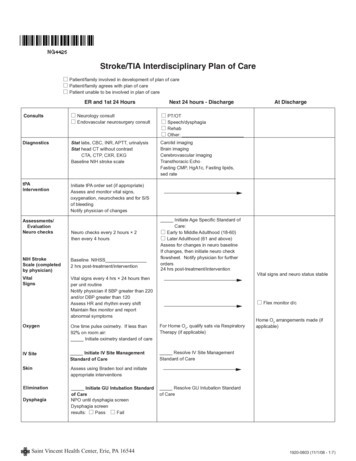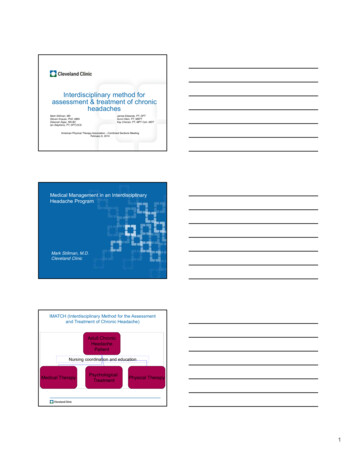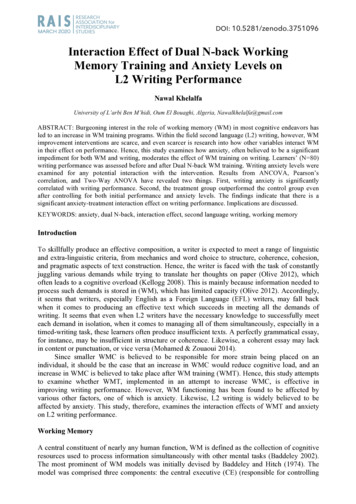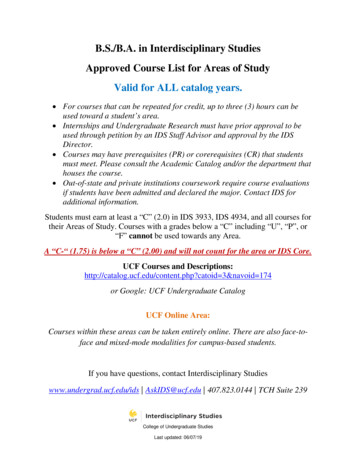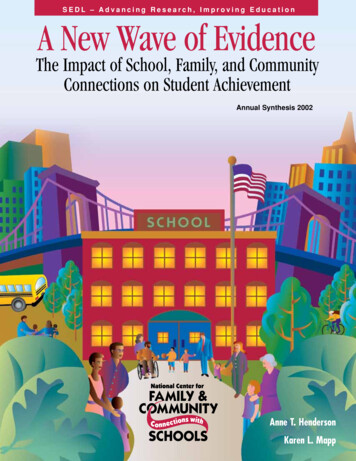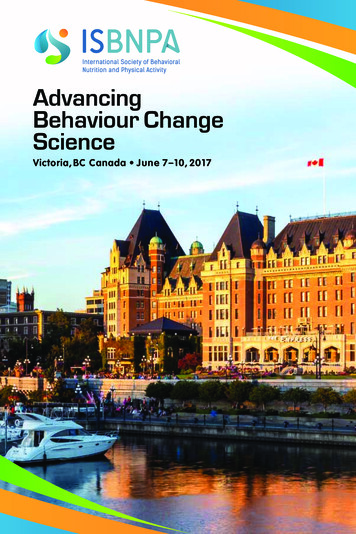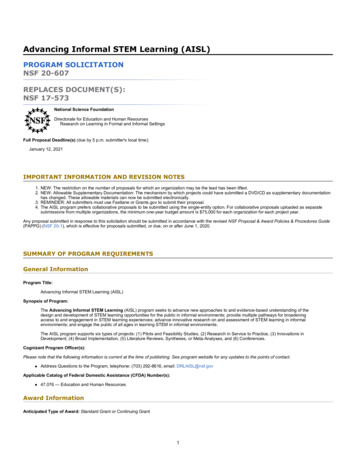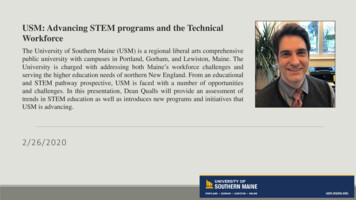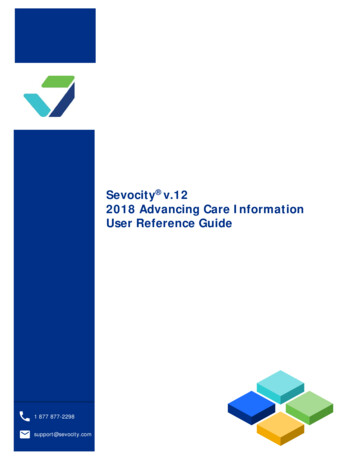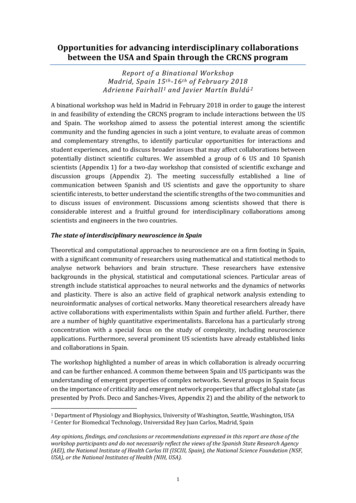
Transcription
Opportunities for advancing interdisciplinary collaborationsbetween the USA and Spain through the CRCNS programReport of a Binational WorkshopMadrid, Spain 15 th -16 th of February 2018Adrienne Fairhall 1 and Javier Martín Buldú 2A binational workshop was held in Madrid in February 2018 in order to gauge the interestin and feasibility of extending the CRCNS program to include interactions between the USand Spain. The workshop aimed to assess the potential interest among the scientificcommunity and the funding agencies in such a joint venture, to evaluate areas of commonand complementary strengths, to identify particular opportunities for interactions andstudent experiences, and to discuss broader issues that may affect collaborations betweenpotentially distinct scientific cultures. We assembled a group of 6 US and 10 Spanishscientists (Appendix 1) for a two-day workshop that consisted of scientific exchange anddiscussion groups (Appendix 2). The meeting successfully established a line ofcommunication between Spanish and US scientists and gave the opportunity to sharescientific interests, to better understand the scientific strengths of the two communities andto discuss issues of environment. Discussions among scientists showed that there isconsiderable interest and a fruitful ground for interdisciplinary collaborations amongscientists and engineers in the two countries.The state of interdisciplinary neuroscience in SpainTheoretical and computational approaches to neuroscience are on a firm footing in Spain,with a significant community of researchers using mathematical and statistical methods toanalyse network behaviors and brain structure. These researchers have extensivebackgrounds in the physical, statistical and computational sciences. Particular areas ofstrength include statistical approaches to neural networks and the dynamics of networksand plasticity. There is also an active field of graphical network analysis extending toneuroinformatic analyses of cortical networks. Many theoretical researchers already haveactive collaborations with experimentalists within Spain and further afield. Further, thereare a number of highly quantitative experimentalists. Barcelona has a particularly strongconcentration with a special focus on the study of complexity, including neuroscienceapplications. Furthermore, several prominent US scientists have already established linksand collaborations in Spain.The workshop highlighted a number of areas in which collaboration is already occurringand can be further enhanced. A common theme between Spain and US participants was theunderstanding of emergent properties of complex networks. Several groups in Spain focuson the importance of criticality and emergent network properties that affect global state (aspresented by Profs. Deco and Sanches-Vives, Appendix 2) and the ability of the network to12Department of Physiology and Biophysics, University of Washington, Seattle, Washington, USACenter for Biomedical Technology, Universidad Rey Juan Carlos, Madrid, SpainAny opinions, findings, and conclusions or recommendations expressed in this report are those of theworkshop participants and do not necessarily reflect the views of the Spanish State Research Agency(AEI), the National Institute of Health Carlos III (ISCIII, Spain), the National Science Foundation (NSF,USA), or the National Institutes of Health (NIH, USA).1
propagate weak signals (Parga). The experimental studies of Sanchez-Vives and Deco onspontaneous and driven global brain activity are supported by whole-brain modeling thatmake predictions about response to perturbation. At a more local scale, Yuste’s work hasdemonstrated that cortical activity patterns can act as attractors and be dynamically createdby optogenetic inputs. Several theoretical approaches to network analysis were presentedthat may provide important tools to understand these observed activity patterns, includingBuldú’s analysis of dynamics and synchronization in complex networks and Makse’sapplication of percolation theory to discover key network nodes. Bielza’s work on graphicalBayesian models has already found applications in collaborations with de Felipe’sanatomical studies of dendritic branching patterns and would be a natural approach toanalyse large-scale EM structural data. Several groups’ work elucidates the identification(de Felipe) and computational role (Geffen, Sanchez-Vives, Yuste) of different neuron types.The climate for extending the reach of interdisciplinary approaches is fertile.Multidisciplinary approaches are well-accepted and broadly under way in this field in Spain,as the speakers’ range of existing local and international collaborations demonstrated.However, it is not yet the case that personnel undertaking theoretical and analyticalapproaches are typically incorporated into neuroscience groups or departments, as hasbecome more common in the US. For example, there is currently no theoretical/analyticalgroup at the Cajal Institute, a major neuroscience center in Madrid, although a number ofmembers do collaborate with theoretical colleagues at other institutes. In terms of academicculture, it was noted that research in the domain of computational neuroscience is generallybetter supported in Spanish computer science departments, with particular strengths innetwork analysis, than in physics departments which remain fairly traditional. In general,the area has gotten more traction in newer departments rather than more long-establishedones. Working across departmental boundaries within institutions remains a barrier, sothat currently there is not as much interaction between theoretical and experimentalgroups as is desirable.Domains that would particularly benefit from the CRCNS program include data science andmachine learning, which is growing in popularity among students and researchers in Spainas in the US and is an opportunity for recruitment and training of students in this area.Brain-computer interfaces (BCI) are also an area of active student interest, particularlynoninvasive BCIs. Neurotechnology, including BCIs, is relatively nascent in Spain and couldbe significantly enhanced through international collaboration.Within Spain, there is specific interest in and room for further growth in computationalneuroscience and neural engineering. Dr Rafael Yuste noted plans for invited visits toseveral institutions in the Basque Country in early 2018, including the Brain Center onCognition, Brain and Language, Nanogune, Biofisika, BioDonostia and the DonostiaInternational Physics Center (DIPC) to give a lecture course in neurophysics. It is possiblethat interactions like this will lead to a new short course in neuroengineering. Further,industrial and medical collaborations are possible: Dr Jose Carmena discussed experiencesfrom his existing collaboration with the Hospital Universitario Donostia in San Sebastiànthat is hosted and partially funded by Tecnalia, a local industry incubator. 33https://www.tecnalia.com/en/2
Current funding mechanismsMINECO is the leading funding organization in Spain, with grants that are in the range of 30-300K over 3 years. They do not include funding for salaries, as these are covered by theinstitution. Some institutions also supply funding for students. European Union fundingsupports two relevant large flagship projects, the Human Brain Project, and GRAPHENE, ananotechnology project. It was perceived among the workshop participants that Spanishfunding policy and mechanisms are slanted toward the support of bigger groups.Computational neuroscience groups tend to be small which disadvantages them in anumber of national and European funding mechanisms. Thus a program like CRCNS couldserve to address this gap.Student trainingThere is considerable potential for teaching and growth in computational neurosciencetraining. It was noted that in Madrid and Barcelona, it could be especially powerful forinstitutions to pool offerings and resources to create an interinstitutional program.Both the US and Spain are very interested in student exchange programs to further trainingand research goals. On the Spanish side, the groundwork for student exchange is already inplace. Graduate exchanges are normal: indeed, in some Spanish doctoral programs, studentsare required to spend some months abroad. This is seen as an ideal opportunity for studentsto learn and exchange new techniques, both experimental and theoretical. Some universityPhD programs require an international component such that students spend some time inanother country, including the US. Further, there exist IBRO fellowships to support one-yearexchanges for very recent graduates.4 Considerable value was also seen in US studentsundertaking research experiences in Spain, to help advance their maturity, collaborativeskills and understanding of the broader international research environment.Intellectual property and the climate for commercializationThe group discussed the opportunities available in both countries for developingintellectual property into companies. This was regarded as a fairly difficult process in Spain.Universities provide guidance but no seed funding, but do assist with filing patents. It wasagreed that from experience, while patents may in the end not mean much, nascentcompanies find them necessary to have in place to secure funding. As in the US, there is adiversity of rules about intellectual property in universities around Spain. In some cases,the IP belongs to the university. Converting from a provisional to a full patent is expensiveand the university may not see the process through. That said, the experiences of attendeessuggest that the culture is changing to offer more support for entrepreneurship. In someplaces, one can take a leave of absence for such efforts, although one cannot continue to befunded by grants on this leave. Sometimes a company may provide funding to a lab to workon an idea, although students generally cannot work on industry-related projects.Importantly, in general, there appear to be no aggressive intellectual property controls inplace that would serve as a barrier to international collaboration.IBRO Research Fellowships,http://funding.ibro1.info/Pub/Pub Main Display.asp?LC Docs ID 425443
Vertebrate animal experimentationVertebrate animal work is in general well-supported by the public in Spain; however, thereis very little research on non-human primates. While it is not banned or even especiallynegatively perceived, under European Union-wide regulations, NHPs should only be usedin projects that are considered essential for human health. There would be no culturalbarrier for interactions that involve NHP experimentation.Data sharingThe question of data sharing generated an active discussion in which a range of diverseviewpoints were shared. While the principle of data sharing is widely seen as positive, manycaveats were raised and discussed.Some participants are members of the Human Brain Project, and shared that the HBPcharter contains a chapter of regulations about data sharing, which has raised awareness ofthe topic, if not yet assured compliance. Sharing of electrophysiology data in particular isseen to be highly nontrivial and there are a range of valid objections to the requirement forimmediate sharing, including the need for intensive documentation; documentationstandards that are time-consuming to carry out; the need for embargo periods to allow thedata-generating group to perform a reasonable amount of publishable analysis; and thequestion of subsequent authorship on research performed using openly shared data. Forsome experiments that are very difficult and time-intensive, a requirement to shareimmediately could be perceived as a disincentive to doing the work. It was noted that datasharing can be complex even within closed collaborations. Finally, some theorists’ hadfound that using publically released data can have limited value—it can act as a “teaser” toinitiate a collaboration, but that a new project will generally require the collection of newdata to advance specific questions.It is generally agreed that a standardized user-friendly platform is required for data sharingto be as useful as possible. The Human Brain Project is in the process of developing such aplatform, but there is a likely two-year timeframe on its development and evaluation.ConclusionsThis workshop demonstrated that there is a fertile ground, scientifically and culturally, forcross-disciplinary collaboration in neuroscience between Spanish and US investigators.Several active collaborations already exist, and specific domains of specialization providevery appropriate opportunities, in particular in the analysis of complex network dynamicsand emergent behavior, in anatomical and cell type analysis, and in brain-computerinterfaces.4
Appendix 1: AttendeesParticipantsNameJavier Martín BuldúGustavo DecoAlbert CompteLuis M. MartínezConcha BielzaJavier de FelipeMavi Sánchez-VivesJoaquín MarroPablo VaronaNéstor PargaJosé CarmenaRafael YusteMaria Neimark-GeffenJudith HirschHernán MakseAdrienne FairhallInstitutionURJC, MadridUPF, BarcelonaIDIBAPS, BarcelonaInstituto de Neurociencias deAlicante. CSIC-UMHUPM, MadridCajal Institute & CTB, MadridIDIBAPS, BarcelonaUniversidad de Granada, GranadaUniversidad Autónoma de Madrid,MadridUniversidad Autónoma de Madrid,MadridUniversity of California, BerkeleyColumbia University, New YorkUniversity of Pennsylvania,PhiladelphiaUniversity of Southern CaliforniaCity University, New YorkUniversity of Washington, SeattleCountrySpainSpainSpainSpainAEI, MINECO, MadridAEI, MINECO, MadridAEI, MINECO, MadridAEI, MINECO, MadridAEI, MINECO, MadridISCIII, MadridAEI, MINECO, nSpainSpainSpainSpainUSAUSAUSAUSAUSAUSAGovernment observersVictoria LeyJoaquín SerranoEstrella FernándezJuan José GarridoAna Mª Barra AhijadoIgnacio BaananteEsther ChacónCampolloMichele FerranteEdda ThielsNIMH, WashingtonNSF, Washington5USAUSA
Appendix 2: Workshop agendaThe binational workshop was preceded by a scientific symposium held at the Cajal Institute,Madrid.PROGRAMME14 February 201816:30 – Welcome and Presentation (Juan José Garrido, Cajal Institute, CSIC, Spain)15:45 – Rafael Yuste: “Can you see a thought? Neuronal ensembles as basic units of corticalfunction”17:15 – José Carmena: “Mechanisms of neural activity exploration and consolidationunderlying neuroprosthetic skill learning”17:45 – Maria N. Geffen: “Excitatory-inhibitory circuits in auditory processing”18:15 – Hernan Makse: “Cracking the locomotion code in C. elegans”19:15 – End of the Scientific SeminarsAGENDA15 February 2018Funders meeting12:00 – Welcome and introduction of State Research Agency(Estrella Fernández Head of Subdivision, Subdivision for Horizontal S&T Programmes,Spanish State Research Agency, AEI)12: 20 – Presentation of National Science Foundation (Edda Thiels, National ScienceFoundation, NSF)12:40 – Presentation of National Institute of Health (Michele Ferrante, National Institute ofHealth, NIH)13:00 – Wrap-upScientific Workshop on CRNCS13:30 – Welcoming reception at AEI- MINECO14:15 – Opening by AEI-MINECO / NSFIntroduction to workshop (Dr Javier M. Buldú, Spanish Co-Chair, URJC University andAdrienne Fairhall, USA Co-Chair, University of Washington)14:30 – Speed topic presentations I: Self-introduction, summary of research, listing ofopportunities for collaboration. (10 minutes each: 8 presentation 2 questions)1) Adrienne Fairhall (University of Washington, Seattle WA)2) Javier M. Buldú (University Rey Juan Carlos, Madrid)3) Gustavo Deco (Universidad Pompeu Fabra, Barcelona)4) Concha Bielza (Universidad Politécnica de Madrid, Madrid)5) José Carmena (UC Berkeley, Berkeley CA)6) Mavi Sánchez-Vives (Institut d’Investigacions Biomèdiques August Pi i SunyerBarcelona),7) Rafael Yuste (Columbia University, New York)8) Luis M. Martínez (Instituto de Neurociencias de Alicante, CSIC-UMH, Alicante)6
16:00 – Coffee break16:30 – Speed topic presentations II (10 minutes each: 8 presentation 2 questions)9) Javier de Felipe (Cajal Institute & CTB, Madrid)10) Néstor Parga (Universidad Autónoma de Madrid, Madrid)11) Hernán Makse (City University, New York)12) Albert Compte (IDIBAPS, Barcelona)13) Joaquín Marro (Universidad de Granada, Granada)14) Judith Hirsch (University of Southern California, CA)15) Pablo Varona (Universidad Autónoma de Madrid, Madrid)16) María N. Geffen (University of Pennsylvania, Philadelphia)18:00 – End of Day 120:00 – Dinner hosted by MINECO/AEI16 February 201809:30 – Group discussion of goals (Chairs)09:45 – Parallel working group session I10:45 – Coffee break11:00 – Parallel working group session II12:00 – Joint session: groups report backSession IScientist working group- open discussionSession IIFunding Agencies working group- open discussion13:00 – Conclusions and next steps13:30 – End of meetingLunch7
Both the US and Spain are very interested in student exchange programs to further training and research goals. On the Spanish side, the groundwork for student exchange is already in place. Graduate exchanges are normal : indeed, i n some Spanish doctoral programs
